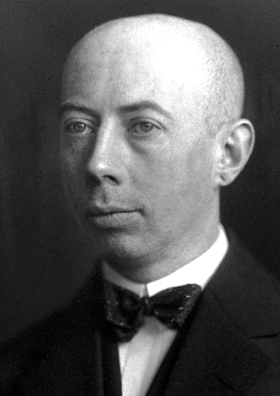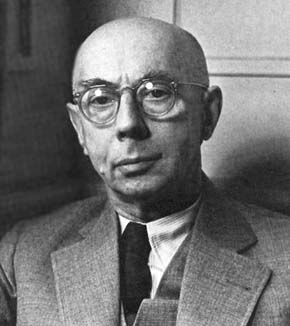<Back to Index>
- Physicist Gustav Ludwig Hertz, 1887
- Architect Jacques Germain Soufflot, 1713
- Duke of Florence Alessandro de' Medici, 1510
PAGE SPONSOR


Gustav Ludwig Hertz (22 July 1887 – 30 October 1975) was a German experimental physicist and Nobel Prize winner, and a nephew of Heinrich Rudolf Hertz.
- 1907), the Ludwig Maximilians University of Munich (1907 – 1908), and the Humboldt University of Berlin (1908 – 1911). He received his doctorate in 1911 under Heinrich Leopold Rubens.
From 1911 to 1914, Hertz was an assistant to Rubens at the University of Berlin. It was during this time that Hertz and James Franck performed experiments on inelastic electron collisions in gases, known as the Franck–Hertz experiments, and for which they received the Nobel Prize in Physics in 1925.
During World War I,
Hertz served in the military from 1914. He was seriously wounded in
1915. In 1917, he returned to the University of Berlin as a Privatdozent. In 1920, he took a job as a research physicist at the Philips Incandescent Lamp Factory in Eindhoven, which he held until 1925. Hertz,
who was concerned for his safety and was looking like his partner to
the Nobel prize win Franck to move to the USA or any other place out of
Germany, Manfred von Ardenne, director of his private laboratory Forschungslaboratorium für Elektronenphysik, Peter Adolf Thiessen, ordinarius professor at the Humboldt University of Berlin and director of the Kaiser-Wilhelm Institut für physikalische Chemi und Elektrochemie (KWIPC) in Berlin-Dahlem, and Max Volmer, ordinarius professor and director of the Physical Chemistry Institute at the Berlin Technische Hochschule, had made a pact. The
pact was a pledge that whoever first made contact with the Russians
would speak for the rest. The objectives of their pact were threefold:
(1) Prevent plunder of their institutes, (2) Continue their work with
minimal interruption, and (3) Protect themselves from prosecution for
any political acts of the past. Before the end of World War II, Thiessen, a member of the Nationalsozialistische Deutsche Arbeiterpartei, had Communist contacts. On
27 April 1945, Thiessen arrived at von Ardenne’s institute in an
armored vehicle with a major of the Soviet Army, who was also a leading
Soviet chemist. All
four of the pact members were taken to the Soviet Union. Hertz was made
head of Institute G, in Agudseri (Agudzery), about 10 km southeast
of Sukhumi and a suburb of Gul’rips (Gulrip’shi). Topics
assigned to Gustav Hertz’s Institute G included: (1) Separation of
isotopes by diffusion in a flow of inert gases, for which Gustav Hertz
was the leader, (2) Development of a condensation pump, for which Justus Mühlenpfordt was
the leader, (3) Design and build a mass spectrometer for determining
the isotopic composition of uranium, for which Werner Schütze was
the leader, (4) Development of frameless (ceramic) diffusion partitions
for filters, for which Reinhold Reichmann was the leader, and (5)
Development of a theory of stability and control of a diffusion
cascade, for which Heinz Barwich was the leader; Barwich had been deputy to Hertz at Siemens. Other members of Institute G were Werner Hartmann and Karl-Franz Zühlke. Von
Ardenne was made head of Institute A. Goals of Manfred von Ardenne’s
Institute A included: (1) Electromagnetic separation of isotopes, for
which von Ardenne was the leader, (2) Techniques for manufacturing
porous barriers for isotope separation, for which Peter Adolf Thiessen
was the leader, and (3) Molecular techniques for separation of uranium
isotopes, for which Max Steenbeck was the leader. In his first meeting with Lavrentij Beria,
von Ardenne was asked to participate in building the bomb, but von
Ardenne quickly realized that participation would prohibit his
repatriation to Germany, so he suggested isotope enrichment as an
objective, which was agreed to. By the end of the 1940s, nearly 300
Germans were working at the institute, and they were not the total work
force. Institute A was used as the basis for the Sukhumi
Physical Technical Institute in Sinop, a suburb of Sukhumi. Volmer went to the Nauchno-Issledovatel’skij Institut-9 (NII-9, Scientific Research Institute No. 9), in Moscow; he was given a design bureau to work on the production of heavy water. In Institute A, Thiessen became leader for developing techniques for manufacturing porous barriers for isotope separation. In 1949, six German scientists, including Hertz, Thiessen, and Barwich were called in for consultation at Sverdlovsk-44, which was responsible for uranium enrichment. The plant, smaller than the American Oak Ridge gaseous diffusion plant, was getting only a little over half of the expected 90% or higher enrichment. After 1950, Hertz moved to Moscow. In 1951, Hertz was awarded a Stalin Prize, second class, with Barwich. In that year, James Franck and Hertz were jointly awarded the Max Planck Medal by the Deutsche Physikalische Gesellschaft. Hertz remained in the Soviet Union until 1955. Upon return from the Soviet Union, Hertz became ordinarius professor at the University of Leipzig. From 1955 to 1967, he was also the chairman of the Physical Society of the Deutsche Demokratische Republik (GDR); he was honorary chairman from 1967 to 1975.
Hertz
was a Member of the German Academy of Sciences in Berlin, Corresponding
Member of the Göttingen Academy of Sciences, an Honorary Member of
the Hungarian Academy of Sciences, a Member of the Czechoslovakian
Academy of Sciences, and a Foreign Member of the USSR Academy of
Sciences.
In 1925, Hertz became ordinarius professor and director of the Physics Institute of the Martin Luther University of Halle-Wittenberg. In 1928 he became ordinarius professor of experimental physics and director of the Physics Institute of the Berlin Technische Hochschule (BTH) in Berlin-Charlottenburg. While there, he developed an isotope separation technique via gaseous
diffusion. Since Hertz was an officer during World War I, he was
temporarily protected from National Socialist policies and the Law for the Restoration of the Professional Civil Service,
but eventually the policies and laws became more stringent, and at the
end of 1934, he was forced to resign his position at BTH, as he was
classified as a “second degree part-Jew”. He then took a position at Siemens, as director of Research Laboratory II. While there, he continued his work on atomic physics and ultrasound, but he eventually discontinued his work on isotope separation. He held this position until he departed for the Soviet Union in 1945.
In 1919, Hertz married Ellen née Dihlmann, who died in 1941. They had two sons, Carl Hellmuth Hertz and Johannes Hertz, both are physicists.